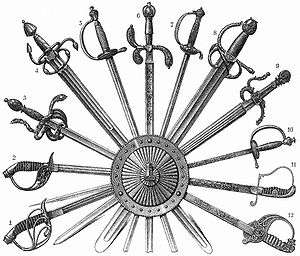Shotel

(Collection of the British Museum)
A shotel is a curved sword originating in Ethiopia. The Ethiopian swordsmen who were trained in using this weapon were known as shotelai. The curve on the shotel's blade varies from the Persian shamshir, adopting an almost semicircular shape. The blade is flat and double-edged with a diamond cross-section. The blade is about 40 inches (1,000 mm) in total length and the hilt is a simple wooden piece with no guard. The shotel was carried in a close fitting leather scabbard.[1]
History
Evidence for the shotel dates from the earliest Damotians (Damites) and Axumites, used by both mounted and dismounted warriors. After the Solomonic restoration of Atse Yikuno Amlak I, the resurgent Emperors began to re-establish the Axumite armies. This culminated in the reign of Amda Seyon I. Ethiopian forces were armed with short and long swords such as the Seif and Gorade. The Shotel swordsmen known as Shotelai and organized in the Axurarat Shotelai comprised one of the elite forces of Amda Seyon's Imperial host. Along with the Hareb Gonda and Korem cavalry, Keste Nihb archers and Axuarat Axuarai lancers were said to be the forces that "flew through the air like the eagle and spun on the ground like the avalanche", by a contemporaneous historian. Shotel techniques among others included hooking attacks both against mounted and dismounted opponents that had devastating effect especially against mounted cavalry. The shotel could be used to hook and rip the warrior off the horse. Classically the Shotel was employed in a dismounted state to hook the opponent by reaching around a shield or any other defensive implement or weapon.[1]
Design
Its shape is similar to a big sickle and can be effectively used to reach around an opponent's shield and stab them in vital areas, such as the kidneys or lungs. It is closely resembled by the Afar Gile. The Gile has two cutting edges, while the shotel's upper edge is unsharpened and sometimes used braced against the swordsman's shield for strength. The Shotel and other Ethiopian swords are occasionally referred collectively in Geez as Han'e.
However, the mid-18th century European visitor to Ethiopia, Remedius Prutky, often used the word shotel to describe a carving knife.[2]
See also
- Sickle sword, a similar weapon used by the Bronze Age Canaanites, Israelites and Ancient Egyptians
- Falx, a curved weapon used by the ancient Thracians.
References
- 1 2
- Stone, George Cameron (1999) [1934]. A Glossary of the Construction, Decoration, and Use of Arms and Armor in All Countries and in All Times. Mineola NY: Dover Publications. p. 562. ISBN 0-486-40726-8.
- ↑ J.H. Arrowsmith-Brown (trans.), Prutky's Travels in Ethiopia and other Countries with notes by Richard Pankhurst (London: Hakluyt Society, 1991), pp. 77, 165.
External links
- "Shotel Sword from Ethiopia". Oriental-Arms. Archived from the original on 2012-02-06. Retrieved 2012-05-20.
